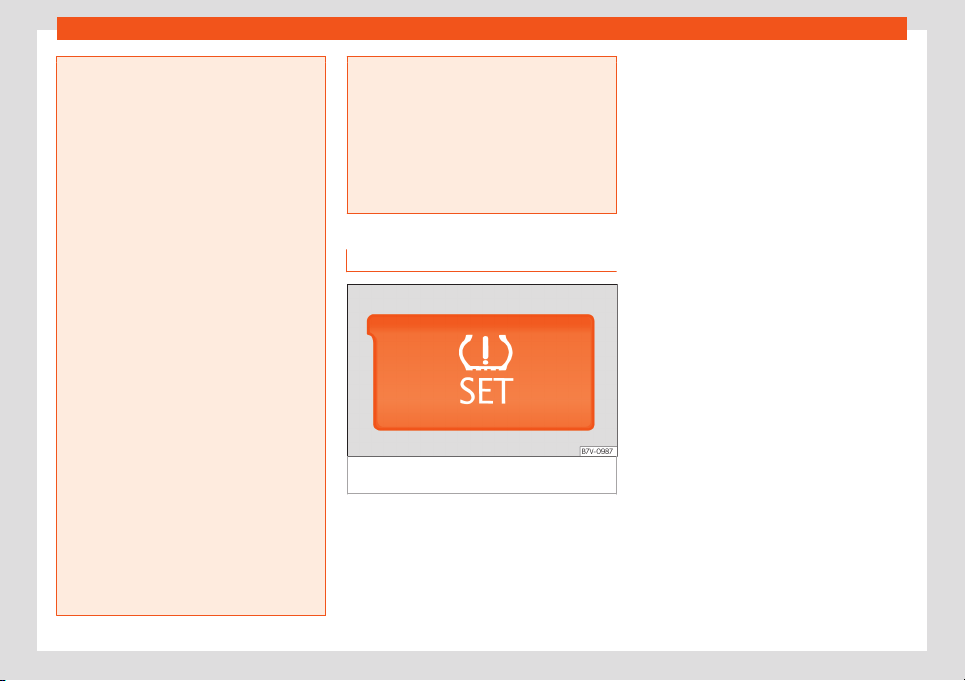Loading ...
Loading ...
Loading ...

Driving
●
If the warning lamp
lights up, stop im-
mediately and check the tyres.
●
If the tyres are inflated at different pres-
sures or if a tyre pressure is too low, this will
increase tyre wear, negatively affecting ve-
hicle stability and increasing braking dis-
tances.
●
If tyres are inflated at different pressures
or a tyre pressure is too low, a tyre may be
damaged and burst resulting in a loss of
control of the vehicle.
●
The driver is responsible for ensuring that
all of the vehicle tyres are correctly infla-
ted to the right pressure. The recommen-
ded tyre pressure is indicated on the label
›››
Fig. 301.
●
The tyre monitoring system can only op-
erate correctly if all of the tyres are infla-
ted to the correct pressure when cold.
●
Driving with tyres at the wrong pressure
can damage them and result in an acci-
dent. Ensure that the tyre pressures of all
the tyres correspond to the vehicle load.
●
Before starting a journey, always inflate
tyres to the correct pressure.
●
If tyre pressure is too low then the tyre is
subject to greater forces and it may be
heated to such an extent that the tread can
rupture and the tyre will burst.
●
With an overloaded vehicle at high
speed, the tyres can overheat and burst re-
sulting in a loss of vehicle control.
●
Tyre pr
essures which are too high or too
low reduce the useful life of the tyre, affect-
ing vehicle performance.
●
If a tyre has not been “punctured” and it
does not have to be changed immediately,
drive to the nearest specialised workshop
at a moderate speed and have the tyre
checked and inflated to the correct pres-
sure.
Tyre monitoring indicator
Fig. 279
Detail of the centre console: button
f
or the t
yr
e pressure monitoring indicator
The tyre monitor indicator compares wheel
r
e
v
olutions and, with this information, the
tread of each wheel using the ABS sensors. If
the tread of a wheel is changed, the tyre
monitoring indicator will indicate as such on
the instrument panel. The wheel tread
changes when:
●
Tyre pressure is insufficient
●
Tyre structure is damaged
●
The vehicle is unbalanced because of a
load
●
If the wheels on an axle are subject to a
heavier load (e.g. when towing a trailer).
●
The vehicle is fitted with snow chains
●
The wheel on one axle is changed
There may be a delay in the reaction of the
tyre monitoring indicator or it may not indi-
cate anything under certain circumstances
(e.g. sports driving, snow-covered or unpaved
roads).
Adaptation of the tyre monitoring indica-
tor
On adjusting tyre pressure or changing one
or more wheels, the
›››
Fig. 279 button on the
tyre monitoring indicator must be kept press-
ed down, with the ignition on, until an audible
warning is heard. Do the same, for example,
when the front and rear wheels are swapped
›››
Fig. 300.
If the wheels are subjected to an excessive
load (towing a trailer, heavy load), the tyre
pressure must be increased to the maximum
recommended pressure
›››
page 338. Press
the tyre monitoring indicator button to con-
firm the new pressure value.
300
Loading ...
Loading ...
Loading ...